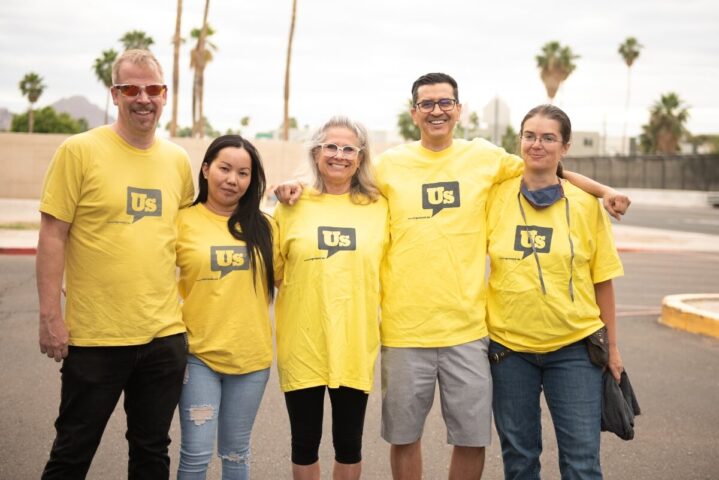How to Take Effective Political Action
How to Lead a Textbank
Textbanking is one of the most effective ways to easily communicate with 1,000, 10,000s even 100,000s of individuals at any given moment in your campaign.
Achieving the appropriate scale that will bring your textbank from helpful to massively impactful requires putting together a team of textbankers that can join forces and work together to reach out to a group of individuals that you want to reach. That means putting together trainings, organizing textbank events and putting into place some structure that will become your organization’s textbank program.
You can do this virtually or base your textbank in person to bring people in your local area together. Here are some great things to consider when starting your textbank program.
Before You Begin
An effective textbank depends on 3 key factors: good management, training, and supervision. This guide will help you execute a successful textbank with your team.

Textbank checklist
- Choose a software. We recommend using a textbank software if it all possible to make your textbank the most efficient. There are plenty to consider at different prices, features and user interfaces.
- Learn how to use your software. Super important that you know your system inside and out before inviting others to join. You’ll need to be able to help troubleshoot and solve tech issues that arise. You’ll also want to learn all the details around setting up your textbank including, uploading your list, building the campaigns and scripts, and reporting and analyzing your results.
- Choose a time to text people. You should text between 12:00 pm Local Time and 9pm Local Time on weekdays and 10:00 am Local Time to 9:00 pm on weekends. Plan on a 1 hour minimum time frame for sending texts.
- Find a place to send texts. You can text from your home, a cafe, office, library, etc. Make sure your space has reliable cell service and wifi.
- Go virtual – you could choose to allow more folks to join from different locations and go virtual. We recommend using a trusted video call software to organize your phonbank supporters.
- Invite your friends, family, and local pro-democracy supporters.
- Communicate details around when, where and how you plan to text so everyone knows where to go and where to be.
- Remind your attendees to bring
- A cell phone
- OR IDEALLY
- A laptop, as this is the best device to use when texting.
- Prep all the materials for texting
- Create a slideshow to train new texters
- Have resources that can provide more information for texters who want to dig deeper – both on how to textbank and the campaign your focused on.
- Make sure your script is error free, approved by the campaign leaders and is loaded into your textbank software.
- Have fun!
- Have a potluck and bring food and drinks for your texters – if online throw a virtual call party.
- Give out stickers or candy as rewards once volunteers reach a certain number of texts – OR post emojis and memes to liven up your virtual event.
- You may also want to bring / or encourage others to bring:
- Extra laptops. (If you’re using a library or community center, check if they have any available)
- This Textbanking 101 Guide
- Scrap paper and pens for jotting down notes, difficult questions, etc from calls
- Snacks or pizza (You can ask people to chip in to cover the cost or rotate who brings what each shift)
- Debrief
Steps for a Successful Text Bank
Step One: Get Organized
To get an effective textbank up and running, you’ll need to do the following:
- Find a place or virtual call space, to get together to send texts. You can text from your home, a cafe, office, library, etc. Make sure your space has reliable cell service and/or wifi.
- Choose a time to text voters. You should text between 12pm Local Time and 9pm Local Time on weekdays and 10am Local Time to 9pm on weekends. Plan on a 1 hour minimum time frame for texts.
- Recruit Volunteers: Over-recruit. Recruit twice as many as you need to account for no-shows! Recruit for specific times and dates and follow up to confirm and remind volunteers when and where their shifts are. An average volunteer textshift is usually somewhere between 2k and 5k total messages.
- Check tech, lists, and internet ahead of time: Prep all the materials you might need prior to other volunteers arriving. Having a textbank coordinator to own these responsibilities can be key to this going well.
Step Two: Create a Volunteer Shift Schedule
Developing — and strictly following — a written schedule for the textbank shifts will ensure that you give the volunteers the information, tools, and practice they need to succeed.
Start with a campaign update, training, and practice. If you have a goal of 2 hours of text time, this should be planned outside that time.

Then send texts out together. Texts are usually some of the most important field work being done on the campaign. With that in mind it is really important that texters are on the phones for the full duration of the planned text time. Signing up for these shifts is a commitment. A few extra texts might not seem like much — but they are. They add up and they make the difference between winning and losing.
Thank your volunteers and sign them up for another shift! We don’t have the money of the Koch brothers or wealthy lobbyists. What we do have is people power so be grateful to all the people who feed that. Personally thank everyone, and have the details of your next textbank ready. Make a group ask as well as individual asks of everyone.
Step Three: Debrief the Texting Shift
After the textbank is finished, bring your team back together in one space and spend some time debriefing. A good debrief is vital to keeping volunteers motivated and troubleshooting any challenges before they arise. During a debrief you should:
- Ask how it went. This will help you build the volunteer relationships, track who’s doing a good job, who has leadership skills and who might be better suited for another activity.
- Ask what voters are saying. Any ‘buzz’ you hear from voters should be reported to your RepresentUs organizer.
- Troubleshoot and address any situations or problems that arose during the shift.
- Praise the volunteers, acknowledging the important work that was accomplished.
- Share Stories. Volunteers should share stories — the good, the bad, the funny — with the entire group. Shared stories will give support and guidance to each other, and if one volunteer had a bad experience, another volunteer could offer sympathy and a solution that worked for them. Sharing stories is a vital part of a debrief.
- Sign volunteers up for their next shifts. Don’t let them leave without telling them when you are textbanking again and having them sign up.
- Thank volunteers repeatedly for their time.
Sample Text Bank Shift Schedule
Training: 5:00pm-5:15pm – Ask new volunteers to come a little early and give them extra background on the campaign. Take extra time going over and practicing the technology.
Briefing: 5:15pm – 5:45pm — Sign people in and get them food. Have people introduce themselves. Share a campaign update. Go over text scripts and materials and field any questions that may come up from your audience. Walk them through what they’ll be doing: what type of script (ie: voter persuasion), what types of voters they will be talking to (base, persuadable, etc…), how their work fits into the plan to win, and briefly what experiences other volunteers have had with these voters.
Contact People: 5:45pm – 7:15pm — Texting! A leader should check in on volunteers having difficulty. It is also good to have a coordinator make reminder phone calls to no-shows.
Debrief: 7:15pm – 7:30pm — Restate importance of their work. Share stories. Thank everyone and ask them back.
